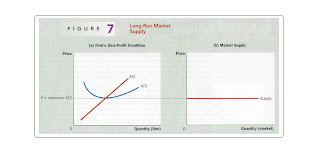
Mostly summarized from Gregory Mankiw’s Principles of Economics, 5 th Ed. PART 5 Firm Behavior and the Organization of Industry Chapter 14 of 36 Firms In Competitive Markets Section 23 of 24 … Figure 8 here … The market response of fi rms to a change in demand depends on the time frame. Firms can enter and exit a market in the long run but not in the short run. Consider a market for milk, beginning at long-run equilibrium. Milk-supplying firms are earning zero economic profit, price equals the minimum of Average Total Cost (ATC). Figure 8 panel (a) shows this initial condition · quantity sold in the market is Q1 · price is P1 · long-run equilibrium is point A … Suppose scientists discover milk has wondrous health benefits. Panel (b) shows the short-run response · demand curve for milk shifts from D1 to D2 · quantity demanded and supplied rises from Q1 to Q2 · price rises fro...



